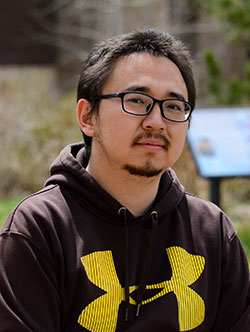
The original University of Wyoming news story can be read here.
University of Wyoming (UW) researchers recently earned an allotment of time on an x-ray beamline at the U.S. Department of Energy’s Advanced Photon Source (APS) at Argonne National Laboratory. X-ray beam time for experimentation at the facility is limited to a nominal 5,000 hous per year and is awarded via a rigorous proposal evaluation system. The UW research team is working to achieve in situ x-ray diffraction (XRD) measurements on a novel catalyst, which is able to convert carbon dioxide mixed with methane into a valuable synthesis gas using a dry-reforming process. The project is led by Jing Zhou, a UW professor of physical chemistry, and Joseph Holles, an adjunct UW professor of chemical engineering.
If the project is successful, the gas rendered through the conversion process can be applied to manufacturing high-demand solvents and chemicals used in making coal-derived engineered products on-site, or simply sold as a commodity product.
UW’s School of Energy Resources’ (SER) Center for Carbon Capture and Conversion (CCCC) funds the project.
“Many industry and academic researchers seek to use the APS facility, and gaining acceptance to use the facility is very competitive,” CCCC Director Richard Horner says. “Over the last three years, the cut-off score that determines successful awards has increased from around 1.9 to 1.4 ― 1 being the best. The project received a final score of 1.3, which suggests that independent reviewers have recognized the work and believe it has significant industrial and scientific importance.”
The catalyst formulation is proprietary and subject to a patent filing, with early laboratory results indicating excellent performance characteristics and behavior. Advances in technology through the sophisticated APS equipment will be the first step in scaling up and commercializing the catalyst.
“We are fortunate to be offered time on the most advanced synchrotron facility globally,” Horner says. “This is a great opportunity for the team to better understand why the catalyst performs in the way it does and generate insights for further performance enhancement as we strive to commercialize our technology.”
According to Horner, the challenge in industrializing the catalyst developed by the team is how to best anchor the active components cerium, titanium and nickel onto an alumina support, which is necessary to provide the mechanical stability. The team has developed about a half-dozen methods for attaching the active components on to the alumina support.
UW doctoral student Qian Yang, of Laramie, has been working to develop an anchor solution for the catalyst as part of his dissertation research. He will travel to the APS facility in July to further advance the project.
“XRD is one of the most used techniques in catalyst studies,” Yang says. “By measuring the intensities and scattering angles of the emitted x-rays of the catalyst sample, XRD can be used for the phase identification of a crystalline catalyst material and provide information on unit cell dimensions.”
The results from the studies at the APS, an Office of Science user facility, will be crucial for selecting the desirable catalyst synthesis formulation and catalyst manufacturing route, he says.
“At APS, we will be able to perform in situ XRD measurement on our catalyst samples under dry reforming of methane reaction conditions. This will allow for the elucidation of active phases evolving during the reaction,” Yang adds.
The Advanced Photon Source is a DOE Office of Science User Facility operated for the DOE Office of Science by Argonne National Laboratory under Contract No. DE-AC02-06CH11357
The U.S. Department of Energy's APS at Argonne National Laboratory is one of the world’s most productive x-ray light source facilities. Each year, the APS provides high-brightness x-ray beams to a diverse community of more than 5,000 researchers in materials science, chemistry, condensed matter physics, the life and environmental sciences, and applied research. Researchers using the APS produce over 2,000 publications each year detailing impactful discoveries, and solve more vital biological protein structures than users of any other x-ray light source research facility. APS x-rays are ideally suited for explorations of materials and biological structures; elemental distribution; chemical, magnetic, electronic states; and a wide range of technologically important engineering systems from batteries to fuel injector sprays, all of which are the foundations of our nation’s economic, technological, and physical well-being.
Argonne National Laboratory seeks solutions to pressing national problems in science and technology. The nation's first national laboratory, Argonne conducts leading-edge basic and applied scientific research in virtually every scientific discipline. Argonne researchers work closely with researchers from hundreds of companies, universities, and federal, state and municipal agencies to help them solve their specific problems, advance America's scientific leadership and prepare the nation for a better future. With employees from more than 60 nations, Argonne is managed by UChicago Argonne, LLC, for the U.S. DOE Office of Science.
The U.S. Department of Energy's Office of Science is the single largest supporter of basic research in the physical sciences in the United States and is working to address some of the most pressing challenges of our time. For more information, visit the Office of Science website.
